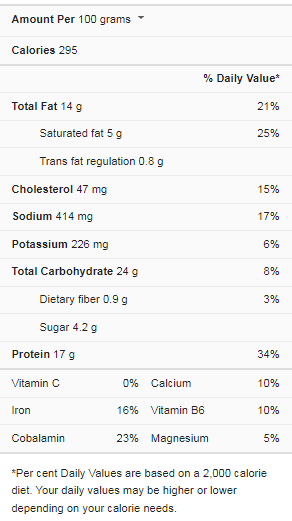Hamburgers are a popular fast food item enjoyed by people of all ages, and they are a staple of American cuisine and can be found in most fast-food restaurants and diners. While they are often viewed as a quick and convenient option, they are also known to be high in calories, fat, and sodium. In this article, we will explore the hamburger nutrition facts to understand better what you’re consuming when you enjoy this classic food.
From the type of meat used to the ingredients added to the bun, we’ll explore the various components that make up a hamburger and how they impact its nutritional value. If you’re a regular hamburger eater or simply curious about this classic food, this article will provide valuable information to help you make informed choices.
A hamburger is a sandwich containing contents between two cut buns or bread rolls (typically a patty of ground meat, usually beef). Hamburgers are frequently served on sesame seed buns with cheese, lettuce, tomato, onion, pickles, bacon, chilis, and condiments including ketchup, mustard, and mayonnaise, relish, or a “special sauce,” which is generally a variant of Thousand Island dressing. A cheeseburger is a hamburger that has been topped with cheese.
Hamburger Nutrition Facts
Even so, a hamburger has some nutritional benefits. It’s high in protein, iron, phosphorus, and other nutrients. Using a whole grain bun for your hamburger may also deliver healthful, nourishing fiber. The nutrition facts for hamburgers are as follows:
Hamburgers have a dreadful rep. They are high in fat and calories. They may be the first meal you eliminate from your diet when you resolve to eat healthier.
Before dismissing them, please look at some health benefits hamburgers can provide. If consumed in moderation, hamburgers, particularly ones made with lean ground beef, can benefit rather than harm your health.
CLA
In 1978, researchers at the University of Wisconsin’s Food Research Institute discovered that grilled hamburger extract had chemicals that inhibited cancer growth. Conjugated linoleic acid, or CLA, is a fatty acid found in abundance in beef. CLA was found to be the chemical in question.
CLA is renowned for its ability to fight inflammatory disorders, including arthritis, to aid weight loss and prevent weight gain.
Choose beef from grass-fed or free-range animals over grain-fed cattle to get the most out of your hamburger. According to the March 2010 issue of “Nutrition Journal,” grass-fed beef contains more CLA but less total fat.
Protein
Protein is found in every cell in your body, essential for optimum health, and it is constantly broken down and replaced. Thus, it must be consumed through the food regularly.
According to the USDA National Nutrient Database, a 3-ounce burger produced with 90% lean ground beef offers protein or nearly 43% of the necessary daily consumption of 50 grams.
Vitamins
Hamburgers include a variety of vitamins, most of which are B vitamins. The B vitamins are required to convert food into energy and form red blood cells. Vitamin B-12 is the most prevalent B vitamin in hamburgers or 100% of adults’ daily intake.
Though all B vitamins are necessary for optimum health, a B-12 shortage can result in significant side effects like anemia, numbness, weakness, and central nervous system issues like fuzzy thinking and loss of balance. B-6, niacin, riboflavin, pantothenic acid, thiamin, and folate are other vitamins in hamburgers. Vitamins E and K are also present in trace amounts in hamburgers.
Minerals
Burgers are rich in minerals, with zinc being the most prevalent. The National Institutes of Health report that a 3-ounce hamburger has 5.4 milligrams of zinc or 36% of the USDA’s recommended daily intake.
Zinc has a variety of functions in the body, including assisting in creating blood cells, supporting metabolism, and enhancing the immune system. Selenium, phosphorus, iron, potassium, magnesium, sodium, copper, calcium, and a trace of manganese and fluoride are other minerals found in hamburgers.
Health Benefits Of Hamburger
Increased Iron Levels
Iron is a vital component that helps your body move oxygen around, boosts your immune system, and aids digestion. Hamburgers are high in heme iron, which is highly bioavailable and easy to digest by your body.
Adult men require roughly eight milligrams (mg) of iron daily. At the same time, women need approximately eight milligrams (mg) per day. A quarter-pound burger made with 90% lean beef includes almost three milligrams, a significant amount of your daily allowance.
Healthy Doses Of Protein
Burger restaurants with a healthy dose of protein Protein are required by every cell in your body to generate new tissue, maintain normal hormone levels, and fight disease. Protein has the added benefit of keeping you fuller for longer, aiding weight loss.
Most dishes at a local burger joint include more protein, which is nearly half of the daily requirement. Choose a low-fat alternative from at least 90% lean beef for the best health outcomes.
Maximum Vitamin B-12 Intake
- Deformed red blood cells can result from a B-12 shortage, leaving you weary, lightheaded, and vulnerable to gastrointestinal disorders.
- A quarter-pound hamburger has roughly three micrograms of B-12, providing you with all your daily requirements in a single meal.
What Is The Difference Between Burger And Hamburgers?
“Burger” is a general term for a sandwich made with a beef patty, typically served on a bun with various condiments and toppings. “Hamburger,” on the other hand, is specifically a type of burger made with a beef patty. The term “hamburger” is often used interchangeably with “burger,” but it technically refers to a specific type of burger. In short, all hamburgers are burgers, but not all are hamburgers.
What Kind Of Meat Does A McDonald’s Hamburger Contain?
“Every one of our burgers is created with 100 percent pure beef and grilled and prepared with nothing but salt, pepper, and nothing else – no fillers, additives, or preservatives,” their website states. Most meat is a ground-up blend of chuck, sirloin, and round.
Our McDonald’s burgers are created entirely of 100 percent pure beef, grilled and seasoned with nothing but salt and pepper—no fillers, additives, or preservatives. We use the trimmings from cuts like chuck, round, and sirloin for our burgers, ground and shaped into patties.
Why Is A Hamburger Called A Hamburger?
When Nagreen was fifteen, he was said to be selling pork sandwiches meant to be eaten while walking at the 1885 Seymour Fair. According to the Historical Society, Nagreen called the hamburger after a Hamburg steak that local German immigrants were familiar with Is.
A beefburger is a hamburger, but a hot sandwich is a cooked ground beef patty served on a sliced bun with salad, veggies, condiments, or both.
In its most basic form, a sandwich consists of slices of meat, cheese, or other food sandwiched between two slices of bread. However, this form of eating must be as old as meat and bread. The term was given to John Montagu, 4th Earl of Sandwich, in the 18th century.
Is There A Difference Between Ground Beef And Hamburger?
Ground beef, which can include meat and trimmings from any primal cuts, is essentially the same as hamburger meat. However, there is a distinction between the two. Ground beef cannot be supplemented with extra beef fat. No other fat may be added; only fat from animal trimmings may be used to prepare ground beef. It can, however, be included in hamburgers.
However, Hamburgers might add fat to the lean mixture to achieve the appropriate fat content level. Ground Round, Ground Sirloin, Ground Chuck. Ground Beef is the four primary forms of ground beef (sometimes known as “hamburger meat”) available in supermarkets.
What Part of a Cow Is Used to Make Hamburgers?
Ground beef is meat that has been gathered and ground from the remainder of larger sections of cattle. Brisket, round, chuck, and sirloin are popular cuts. The name of the cow’s body part from which it was taken is typically written on the label.
This ratio will be labeled “lean ground beef” in the grocery shop. Ground chuck, scraps ground from the chuck roast found behind the cow’s shoulder, is commonly used. Burgers, meatballs, and meatloaf can all benefit from the ground chuck.
If you hadn’t guessed, dirty refers to burger preparation. The more garnish you add for flavor, the messier and calorie-dense it becomes (dirty is a personal choice).
Which Nation Consumes The Most Hamburgers?
The United States consumes the most incredible amount of fast food globally. Burgers are the most popular fast food item. They account for over half of fast-food spending in The History of the Hamburger.
You may know that Hamburg, Germany, is the birthplace of hamburgers. In fact, according to some, the concept of minced beef predates Hamburg. Hawaii was the most expensive state, with $379 per capita annual spending. According to the study, Oklahomans eat 267 burgers per year.
Conclusion
In conclusion, hamburgers are a popular and tasty food item. It’s important to consider their nutritional value when incorporating them into a balanced diet. Hamburgers are high in calories, fat, and sodium. It can contribute to weight gain and other health problems if consumed excessively.
However, by making mindful choices when ordering and adding healthier toppings, hamburgers can still be a part of a balanced diet. It’s essential to balance indulging in the occasional hamburger and incorporating nutrient-dense foods into your meals to maintain overall health and wellness.


